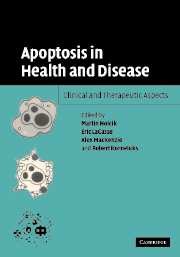Book contents
- Frontmatter
- Contents
- List of contributors
- Preface
- 1 Apoptosis in health, disease, and therapy: overview and methodology
- 2 Developmental apoptosis in health and disease
- 3 Apoptosis and cancer
- 4 Neuronal cell death in human neurodegenerative diseases and their animal/cell models
- 5 Apoptosis in the cardiovascular system: incidence, regulation, and therapeutic options
- 6 Cytotoxic lymphocytes, apoptosis, and autoimmunity
- 7 Pro- and anti-apoptotic strategies of viruses
- Index
- Plate section
- References
7 - Pro- and anti-apoptotic strategies of viruses
Published online by Cambridge University Press: 03 March 2010
- Frontmatter
- Contents
- List of contributors
- Preface
- 1 Apoptosis in health, disease, and therapy: overview and methodology
- 2 Developmental apoptosis in health and disease
- 3 Apoptosis and cancer
- 4 Neuronal cell death in human neurodegenerative diseases and their animal/cell models
- 5 Apoptosis in the cardiovascular system: incidence, regulation, and therapeutic options
- 6 Cytotoxic lymphocytes, apoptosis, and autoimmunity
- 7 Pro- and anti-apoptotic strategies of viruses
- Index
- Plate section
- References
Summary
Introduction
Apoptosis (Kerr et al., 1972) or programmed cell death is a highly regulated and precisely coordinated program permitting the specific elimination of target cells, while neighboring cells are hardly affected. The remains of the apoptotic cells are then readily digested by phagocytes. Apoptosis is an important function in cell differentiation, embryonal development, and proliferation control. In the immune system, apoptosis is the key to the deletion of auto-reactive lymphocytes, to the regulation and restriction of immune responses, and to the elimination of cells infected by intracellular pathogens such as viruses. Consequently, defects in apoptotic pathways are associated with tumor development, autoimmune disease, immunodeficiency, and severe infections. The efficient and cautious elimination of virus-infected cells by apoptosis also degrades viral nucleic acids, even of genomically integrated proviruses. Thus, non-infectious fragments are produced, preventing the uptake of functional viral genomes by neighboring cells or phagocytes. Simultaneously, apoptotic protein material can be processed by phagocytes and other antigen-presenting cells for the presentation to helper and effector immune cells. While pro-apoptotic mechanisms are utilized by some viruses in their life cycle – e.g. for the efficient release of infectious particles – many viruses have developed anti-apoptotic functions for preventing the premature termination of their replicative cycle and for establishing latent persistence (Hay and Kannourakis, 2002). Some viruses even induce apoptosis for attacking immune cells which are directed against the virus-infected cells. Viruses utilize proteins with functional and often structural homology to cellular factors involved in apoptosis.
- Type
- Chapter
- Information
- Apoptosis in Health and DiseaseClinical and Therapeutic Aspects, pp. 219 - 245Publisher: Cambridge University PressPrint publication year: 2005



